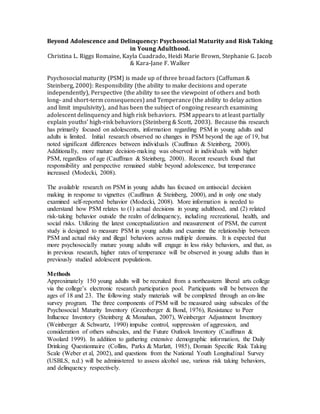
PSM College Study
- 1. Beyond Adolescence and Delinquency: Psychosocial Maturity and Risk Taking in Young Adulthood. Christina L. Riggs Romaine, Kayla Cuadrado, Heidi Marie Brown, Stephanie G. Jacob & Kara-Jane F. Walker Psychosocial maturity (PSM) is made up of three broad factors (Caffuman & Steinberg, 2000): Responsibility (the ability to make decisions and operate independently), Perspective (the ability to see the viewpoint of others and both long- and short-term consequences) and Temperance (the ability to delay action and limit impulsivity), and has been the subject of ongoing research examining adolescent delinquency and high risk behaviors. PSM appears to at least partially explain youths’ high-risk behaviors (Steinberg & Scott, 2003). Because this research has primarily focused on adolescents, information regarding PSM in young adults and adults is limited. Initial research observed no changes in PSM beyond the age of 19, but noted significant differences between individuals (Cauffman & Steinberg, 2000). Additionally, more mature decision-making was observed in individuals with higher PSM, regardless of age (Cauffman & Steinberg, 2000). Recent research found that responsibility and perspective remained stable beyond adolescence, but temperance increased (Modecki, 2008). The available research on PSM in young adults has focused on antisocial decision making in response to vignettes (Cauffman & Steinberg, 2000), and in only one study examined self-reported behavior (Modecki, 2008). More information is needed to understand how PSM relates to (1) actual decisions in young adulthood, and (2) related risk-taking behavior outside the realm of delinquency, including recreational, health, and social risks. Utilizing the latest conceptualization and measurement of PSM, the current study is designed to measure PSM in young adults and examine the relationship between PSM and actual risky and illegal behaviors across multiple domains. It is expected that more psychosocially mature young adults will engage in less risky behaviors, and that, as in previous research, higher rates of temperance will be observed in young adults than in previously studied adolescent populations. Methods Approximately 150 young adults will be recruited from a northeastern liberal arts college via the college’s electronic research participation pool. Participants will be between the ages of 18 and 23. The following study materials will be completed through an on-line survey program. The three components of PSM will be measured using subscales of the Psychosocial Maturity Inventory (Greenberger & Bond, 1976), Resistance to Peer Influence Inventory (Steinberg & Monahan, 2007), Weinberger Adjustment Inventory (Weinberger & Schwartz, 1990) impulse control, suppression of aggression, and consideration of others subscales, and the Future Outlook Inventory (Cauffman & Woolard 1999). In addition to gathering extensive demographic information, the Daily Drinking Questionnaire (Collins, Parks & Marlatt, 1985), Domain Specific Risk Taking Scale (Weber et al, 2002), and questions from the National Youth Longitudinal Survey (USBLS, n.d.) will be administered to assess alcohol use, various risk taking behaviors, and delinquency respectively.
- 2. Results/Discussion Recruitment will begin in early 2014, and completion is anticipated in April 2014. This paper will expand upon the current body of research by describing PSM in young adulthood, as well as examining the relationship between PSM, actual risk taking behavior in young adults, and recent and historical delinquent activity. Implications for future research and further study of the development of PSM will be discussed. Submission # ind143737